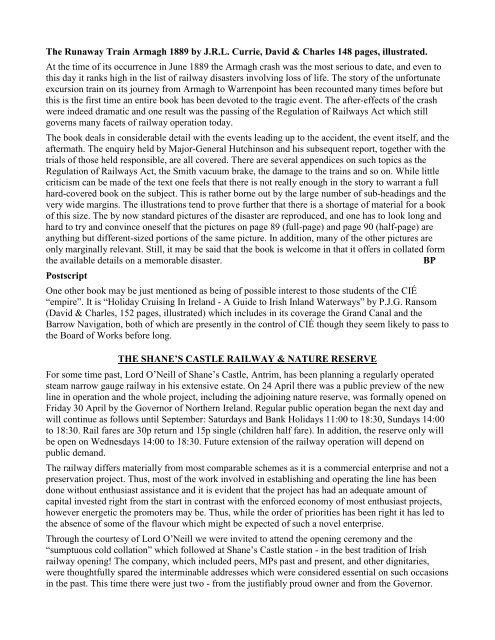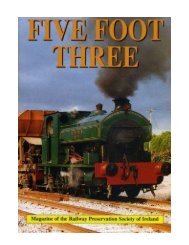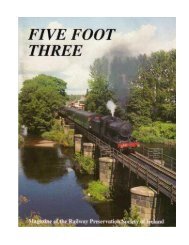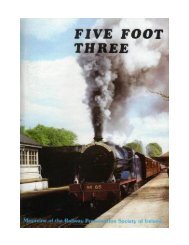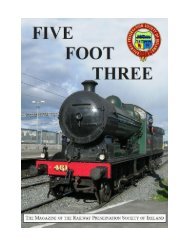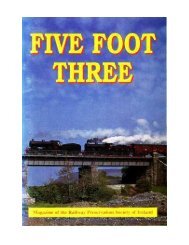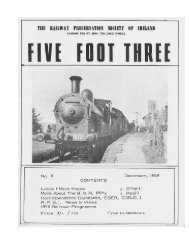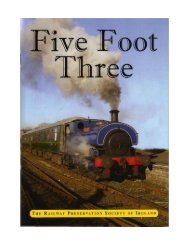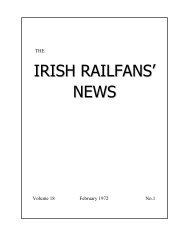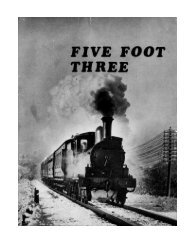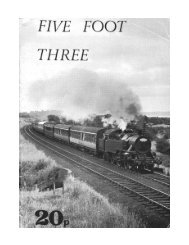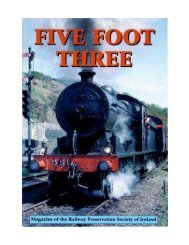No.3 - Steam trains on Irish Railways with RPSI - Railway
No.3 - Steam trains on Irish Railways with RPSI - Railway
No.3 - Steam trains on Irish Railways with RPSI - Railway
You also want an ePaper? Increase the reach of your titles
YUMPU automatically turns print PDFs into web optimized ePapers that Google loves.
The Runaway Train Armagh 1889 by J.R.L. Currie, David & Charles 148 pages, illustrated.At the time of its occurrence in June 1889 the Armagh crash was the most serious to date, and even tothis day it ranks high in the list of railway disasters involving loss of life. The story of the unfortunateexcursi<strong>on</strong> train <strong>on</strong> its journey from Armagh to Warrenpoint has been recounted many times before butthis is the first time an entire book has been devoted to the tragic event. The after-effects of the crashwere indeed dramatic and <strong>on</strong>e result was the passing of the Regulati<strong>on</strong> of <strong><strong>Railway</strong>s</strong> Act which stillgoverns many facets of railway operati<strong>on</strong> today.The book deals in c<strong>on</strong>siderable detail <strong>with</strong> the events leading up to the accident, the event itself, and theaftermath. The enquiry held by Major-General Hutchins<strong>on</strong> and his subsequent report, together <strong>with</strong> thetrials of those held resp<strong>on</strong>sible, are all covered. There are several appendices <strong>on</strong> such topics as theRegulati<strong>on</strong> of <strong><strong>Railway</strong>s</strong> Act, the Smith vacuum brake, the damage to the <str<strong>on</strong>g>trains</str<strong>on</strong>g> and so <strong>on</strong>. While littlecriticism can be made of the text <strong>on</strong>e feels that there is not really enough in the story to warrant a fullhard-covered book <strong>on</strong> the subject. This is rather borne out by the large number of sub-headings and thevery wide margins. The illustrati<strong>on</strong>s tend to prove further that there is a shortage of material for a bookof this size. The by now standard pictures of the disaster are reproduced, and <strong>on</strong>e has to look l<strong>on</strong>g andhard to try and c<strong>on</strong>vince <strong>on</strong>eself that the pictures <strong>on</strong> page 89 (full-page) and page 90 (half-page) areanything but different-sized porti<strong>on</strong>s of the same picture. In additi<strong>on</strong>, many of the other pictures are<strong>on</strong>ly marginally relevant. Still, it may be said that the book is welcome in that it offers in collated formthe available details <strong>on</strong> a memorable disaster.BPPostscriptOne other book may be just menti<strong>on</strong>ed as being of possible interest to those students of the CIÉ“empire”. It is “Holiday Cruising In Ireland - A Guide to <strong>Irish</strong> Inland Waterways” by P.J.G. Ransom(David & Charles, 152 pages, illustrated) which includes in its coverage the Grand Canal and theBarrow Navigati<strong>on</strong>, both of which are presently in the c<strong>on</strong>trol of CIÉ though they seem likely to pass tothe Board of Works before l<strong>on</strong>g.THE SHANE’S CASTLE RAILWAY & NATURE RESERVEFor some time past, Lord O’Neill of Shane’s Castle, Antrim, has been planning a regularly operatedsteam narrow gauge railway in his extensive estate. On 24 April there was a public preview of the newline in operati<strong>on</strong> and the whole project, including the adjoining nature reserve, was formally opened <strong>on</strong>Friday 30 April by the Governor of Northern Ireland. Regular public operati<strong>on</strong> began the next day andwill c<strong>on</strong>tinue as follows until September: Saturdays and Bank Holidays 11:00 to 18:30, Sundays 14:00to 18:30. Rail fares are 30p return and 15p single (children half fare). In additi<strong>on</strong>, the reserve <strong>on</strong>ly willbe open <strong>on</strong> Wednesdays 14:00 to 18:30. Future extensi<strong>on</strong> of the railway operati<strong>on</strong> will depend <strong>on</strong>public demand.The railway differs materially from most comparable schemes as it is a commercial enterprise and not apreservati<strong>on</strong> project. Thus, most of the work involved in establishing and operating the line has beend<strong>on</strong>e <strong>with</strong>out enthusiast assistance and it is evident that the project has had an adequate amount ofcapital invested right from the start in c<strong>on</strong>trast <strong>with</strong> the enforced ec<strong>on</strong>omy of most enthusiast projects,however energetic the promoters may be. Thus, while the order of priorities has been right it has led tothe absence of some of the flavour which might be expected of such a novel enterprise.Through the courtesy of Lord O’Neill we were invited to attend the opening cerem<strong>on</strong>y and the“sumptuous cold collati<strong>on</strong>” which followed at Shane’s Castle stati<strong>on</strong> - in the best traditi<strong>on</strong> of <strong>Irish</strong>railway opening! The company, which included peers, MPs past and present, and other dignitaries,were thoughtfully spared the interminable addresses which were c<strong>on</strong>sidered essential <strong>on</strong> such occasi<strong>on</strong>sin the past. This time there were just two - from the justifiably proud owner and from the Governor.


